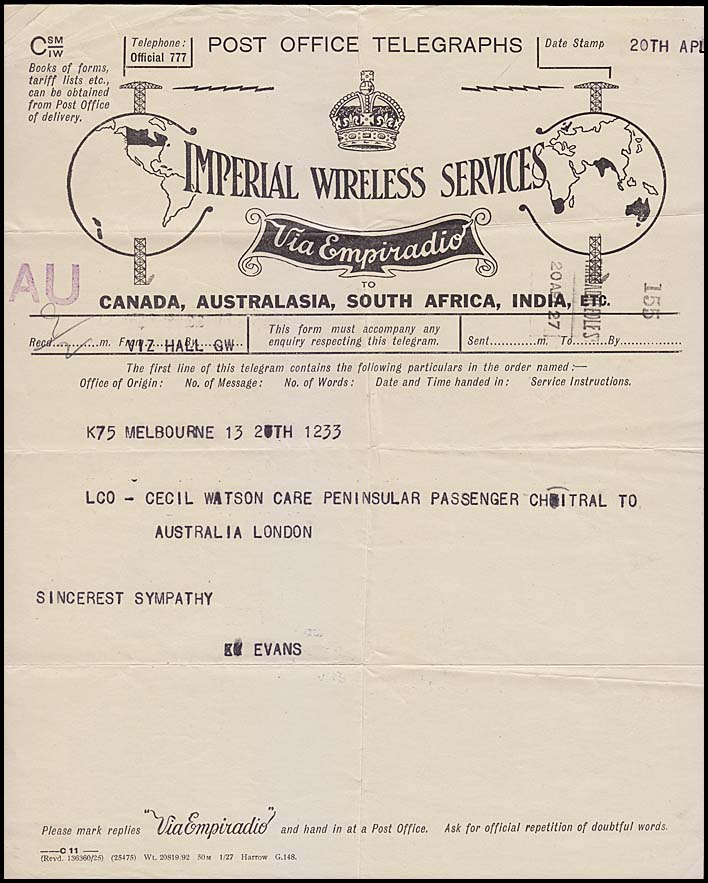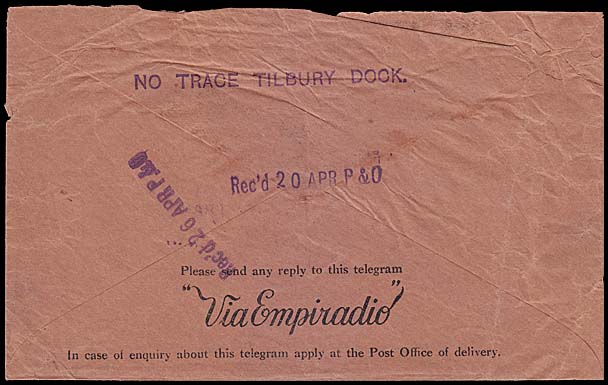Shore to ship telegraphy.
- Home, index, site details
- Australia 1901-1988
- New South Wales
- Overview of NSW
- Telegraph lines
- Telegraph Offices
- Date stamps
- Forms
- Envelopes
- Rates
- Stamps
- Queensland
- Overview of Qld
- Telegraph lines
- Telegraph offices
- Date stamps
- Forms
- Envelopes
- Rates
- Stamps
- South Australia
- Overview of SA
- Telegraph lines
- Telegraph Offices
- Date stamps
- Forms
- Envelopes
- Rates
- Stamps
- Tasmania
- Overview of Tasmania
- General developments
- Reports
- Organisation
- Telegraph lines
- Telegraph Offices
- Date stamps
- Railway lines
- Forms
- Envelopes
- Rates
- Stamps
- Overview of Tasmania
- Victoria
- Overview of Vic.
- Telegraph lines
- Telegraph offices
- Date stamps
- Forms
- Envelopes
- Rates
- Stamps
- Ephemera
- Western Australia
- Overview of WA
- Telegraph lines
- Telegraph Offices
- Date stamps
- Forms
- Envelopes
- Rates
- Stamps
Telegrams for delivery to a ship's passenger could be sent:
- through the usual wires to the nearest telegraph office, transcribed on to a normal delivery form and then delivered by messenger. Such an arrangement was commonly used when a ship was still at the dock or about to berth;
- direct to a telegraphic receiver on board a vessel and delivered by one of the crew. This arrangement was really only used when a ship was underway.
Examples of telegrams sent in either of these ways are included below.
1. Sent through the usual wires.
After a short mutiny on 1 June by several sailors because they wanted an extra day’s leave in Fremantle, she sailed for the east coast. A total of 32 crew were tried for mutiny with an additional 5 held over for trial after arrival in Sydney on 20 June. This telegram would therefore have reached the ship while she docked briefly in Melbourne. |
Brisbane to H.M.A.S. AUSTRALIA berthed in Port Melbourne. Telegram recorded on the trial combined envelope and delivery form and printed April 1918.
|
 |
AA-DO-13C. Message sent from Highett, Victoria to the S.S. Iberia while she was docked and awaiting departure from Sydney. 17 May 1962. |
This use of telegrams was both promoted and accepted widely. From the early 1930s, advertisements appeared in mazazines and newspapers describing what a good way to convey wishes to travellers. The promotions worked - it was estimated that ships in port received an average of about 1 telegram for each passenger - wuite a lot fo ships carring over 1,000 passengers.
2. Sent while the vessel was under steam.
Also refer to a range of Marconi forms elsewhere.
 |
IMW-DO-2. Telegram lodged by a Melbourne subscriber and sent to the S.S. Oronsay via the Adelaide Coastal Radio station. The form is for Ship-to-Ship of Shore-to-Ship communications. |
 |
Reverse side of the above Marconigram showing an elaborate advertisement for the Savoy Hotel in London. |
 |
The delivery envelope used to delivery the above telegram to Miss Poole. Clearly there was some confusion as to which cabin she was in - either 87 or 122. |
 |
Post Office Telegraphs (England) form for the Imperial Wireless Services (Empiradio). 20 April 1927. Message sent from Melbourne to Passenger Watson thought to be on board the S.S. Chitral - part of the Peninsular and Orient (later P&O) fleet - sailing to Australia. But see below. |
 |
Delivery envelope for Empiradio messages. Clearly tied to the above message by the number 155. But - Ms.Watson does not seem to have been aboard the Chitral (at least by that name). |
 |
There does not appear to have been any trace of her at the Tilbury Dock. Whatever happened subsequently is not now known. It does appear that the telegram was finally delivered. |
